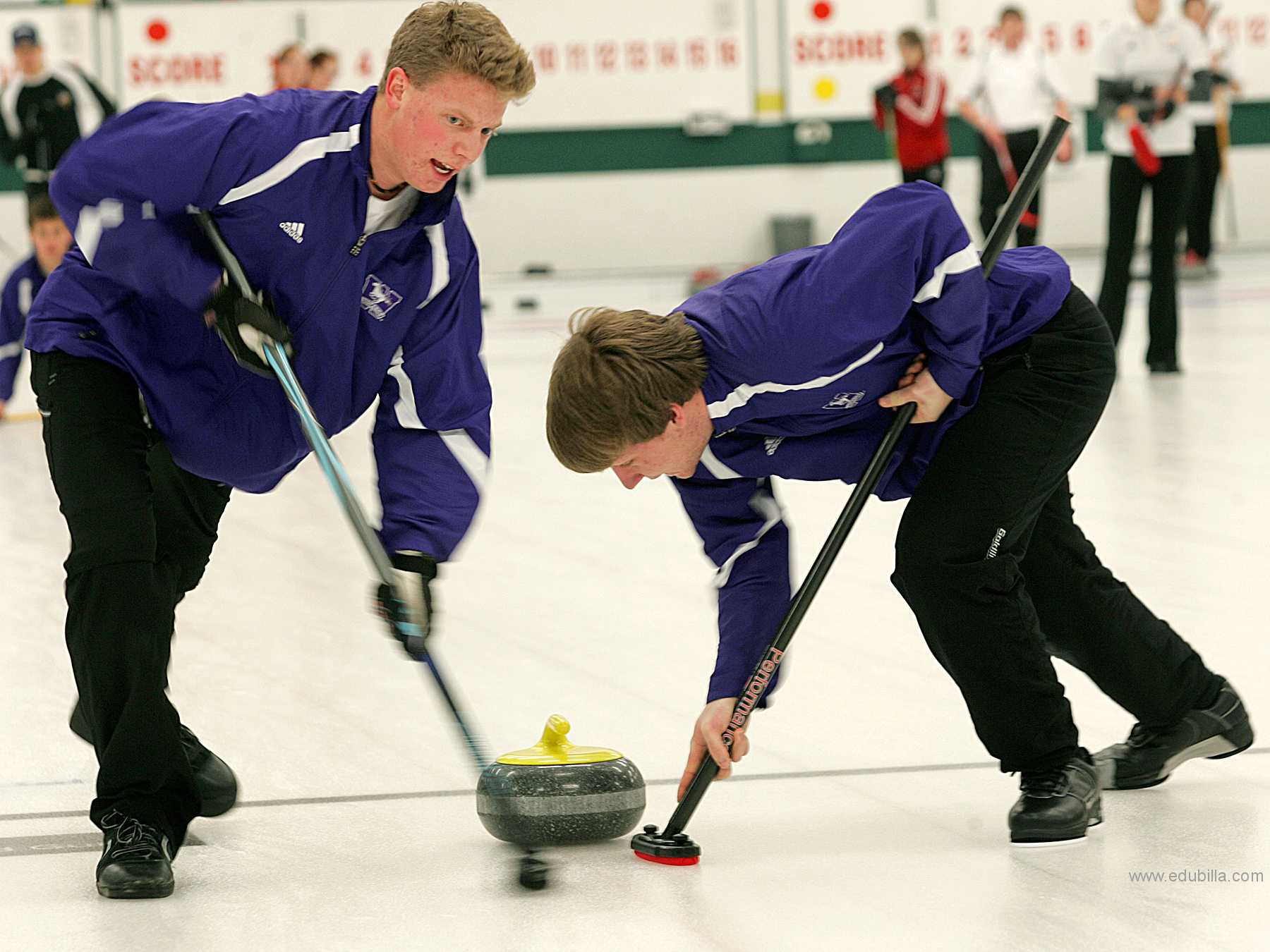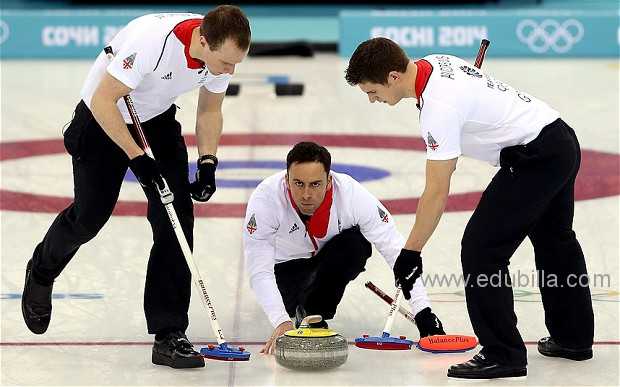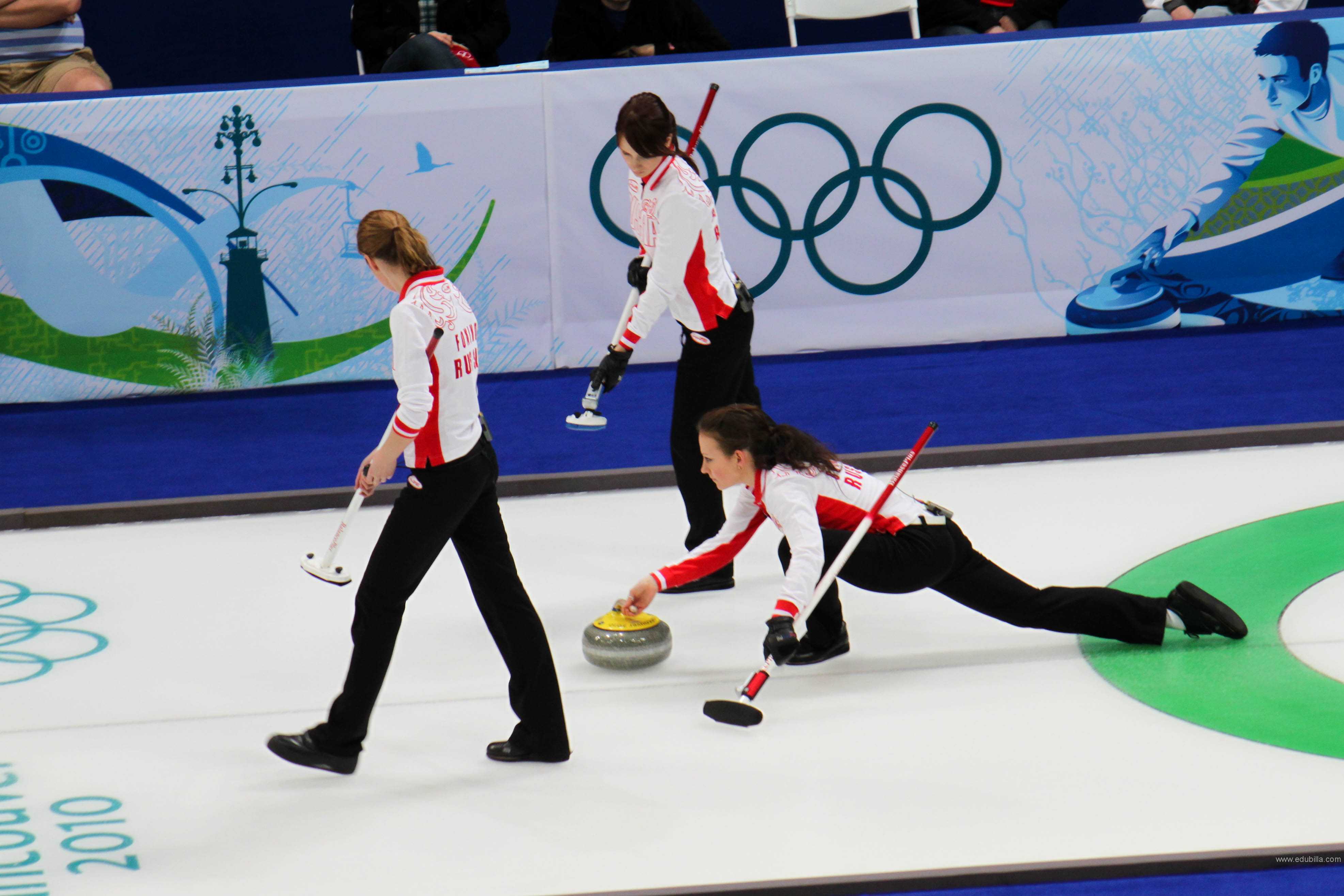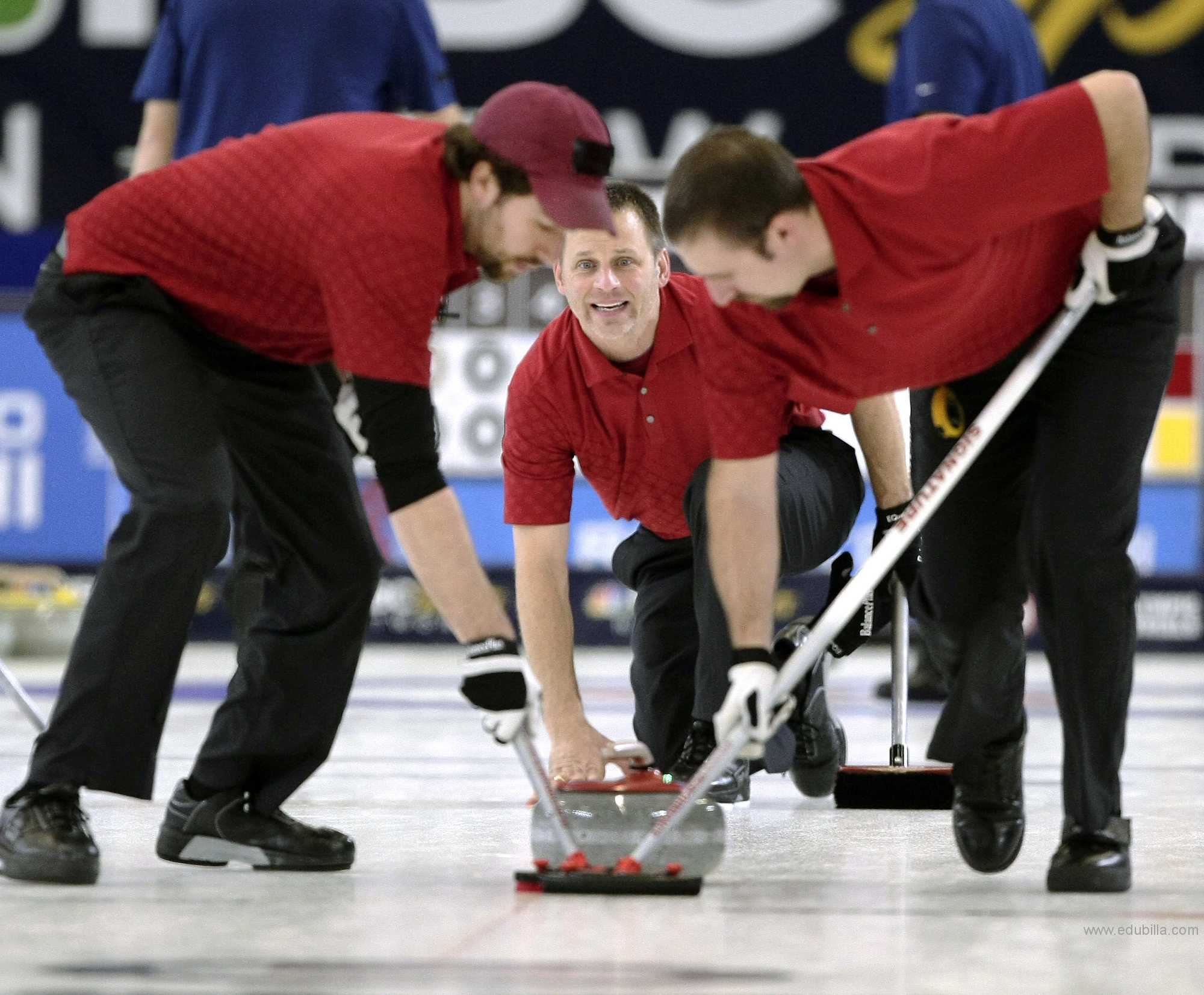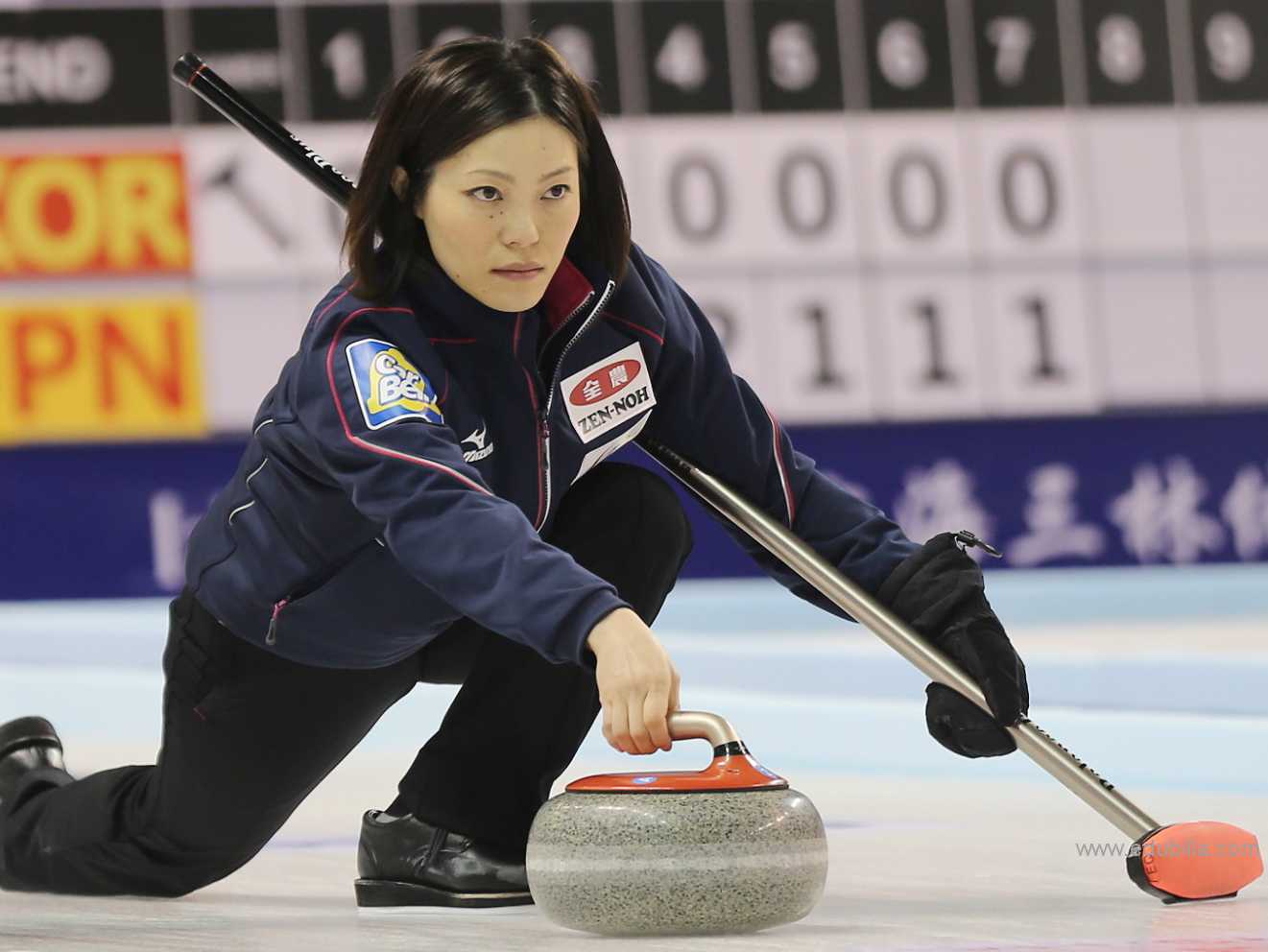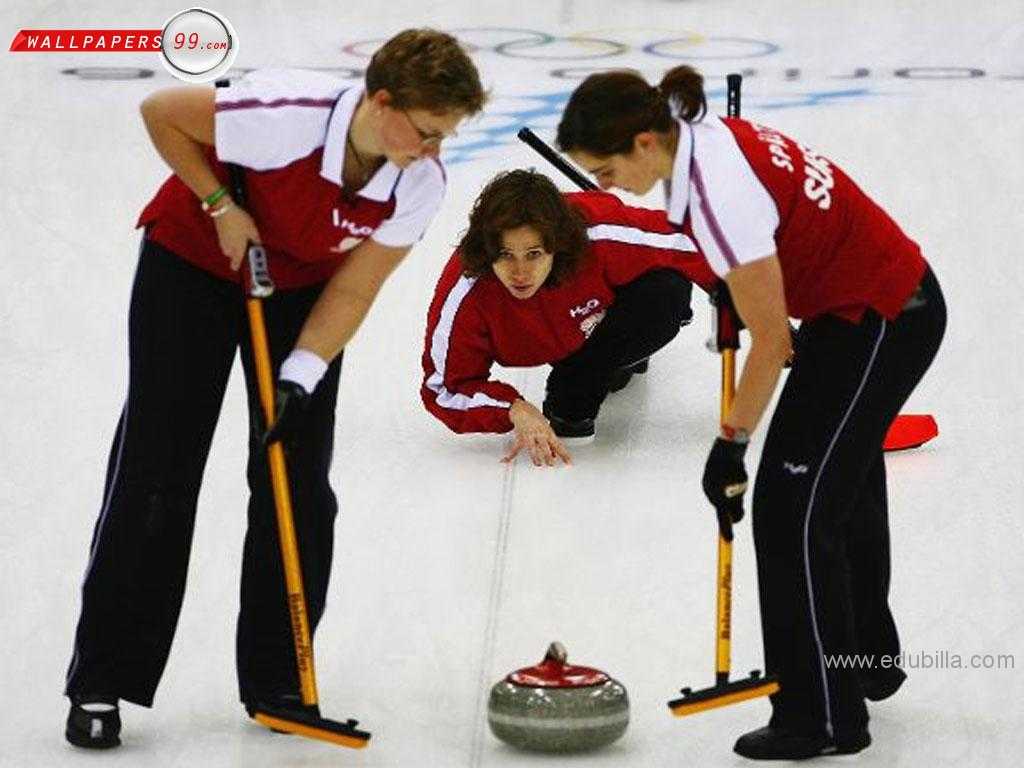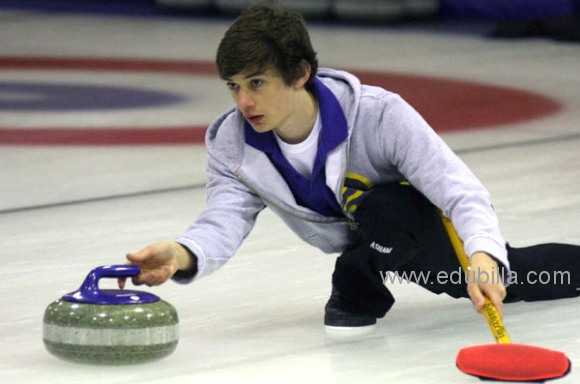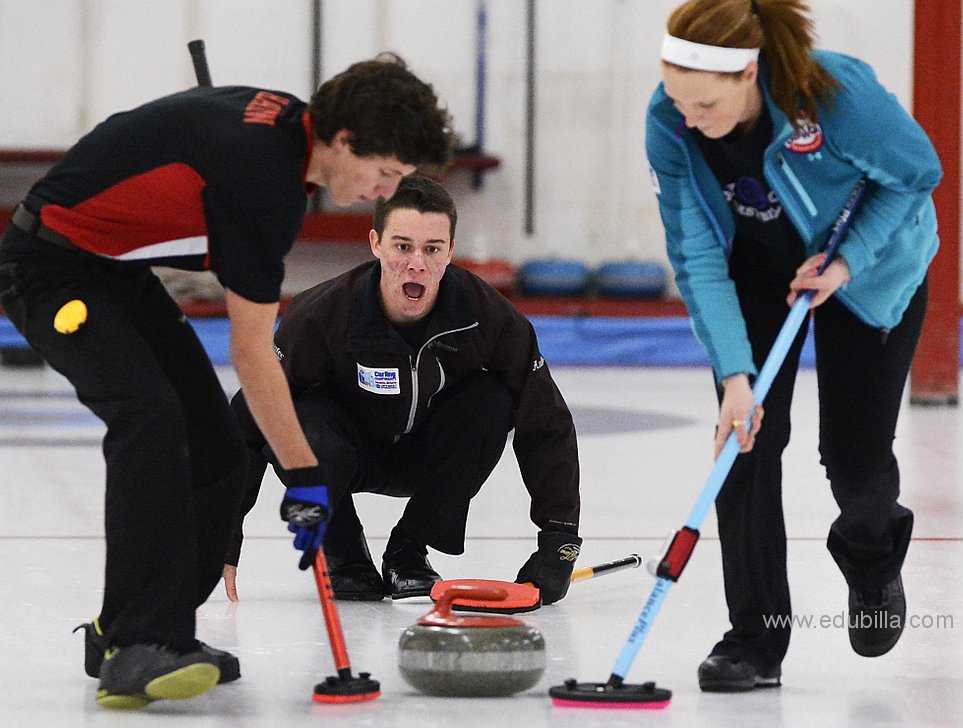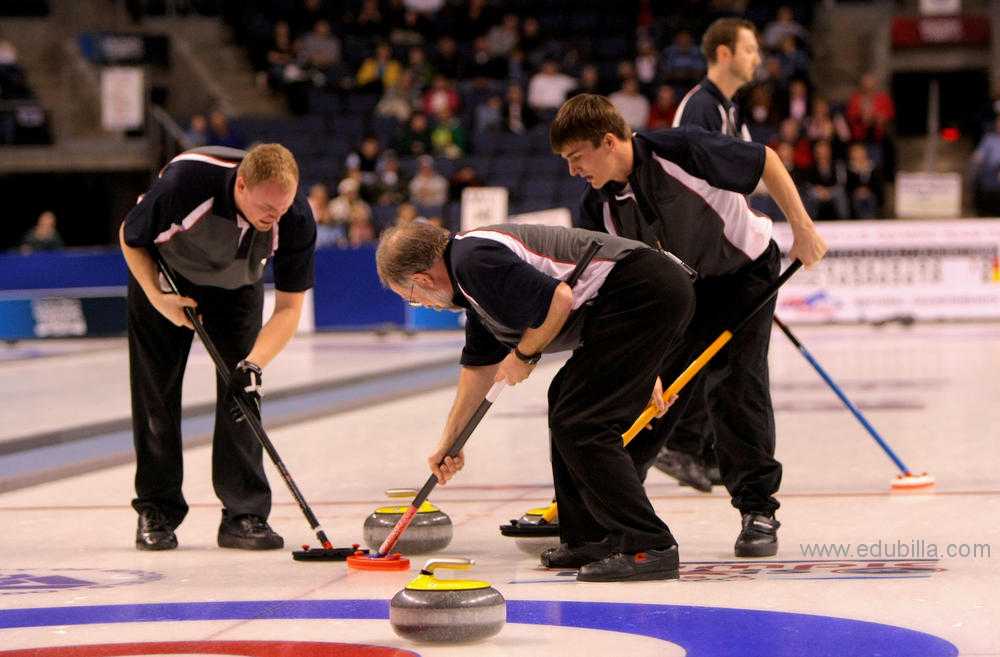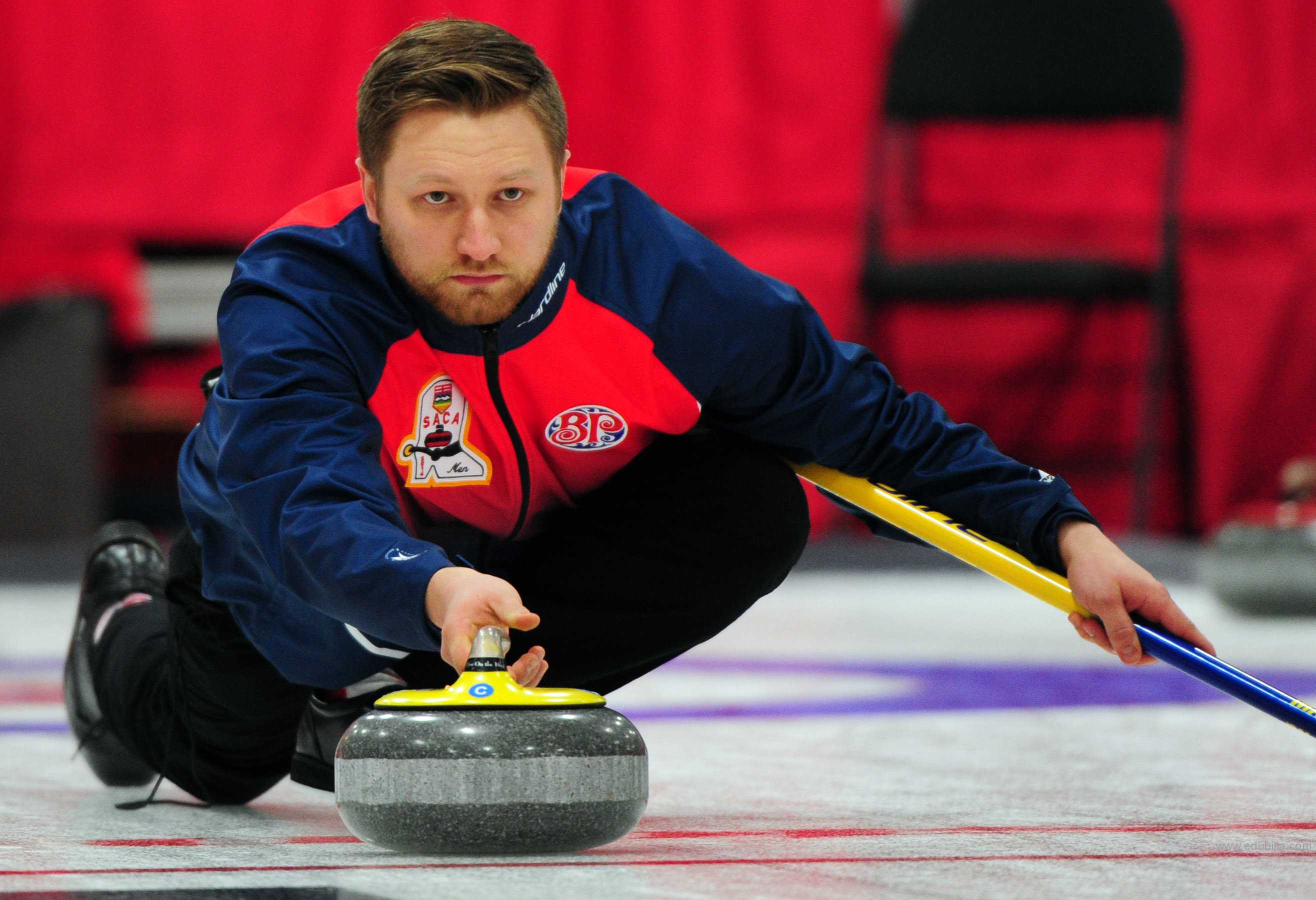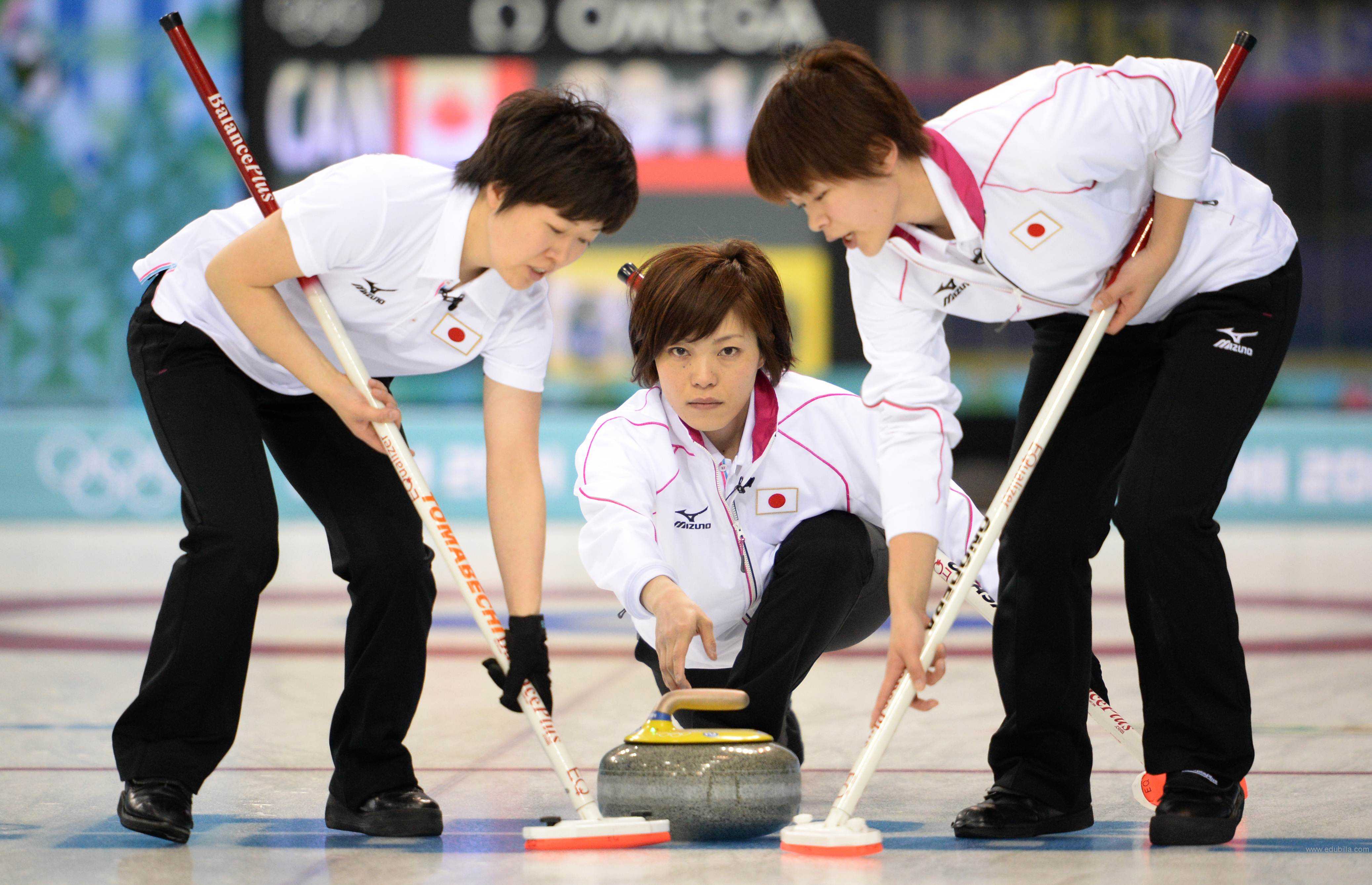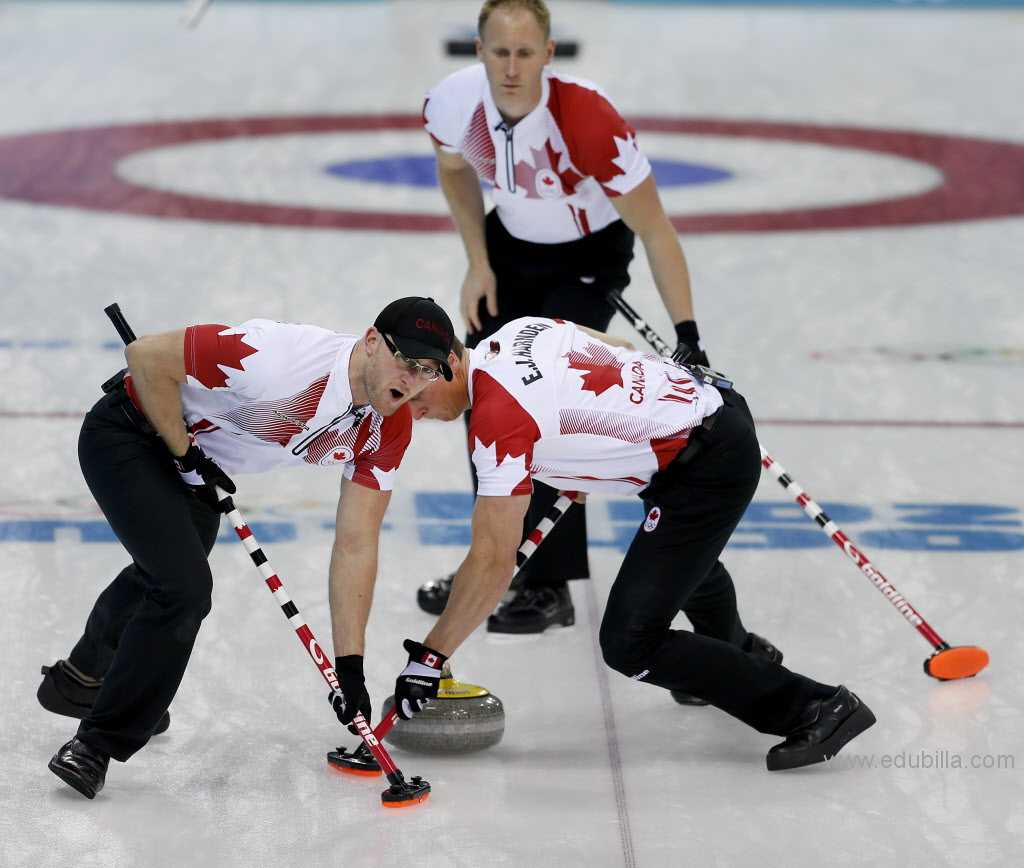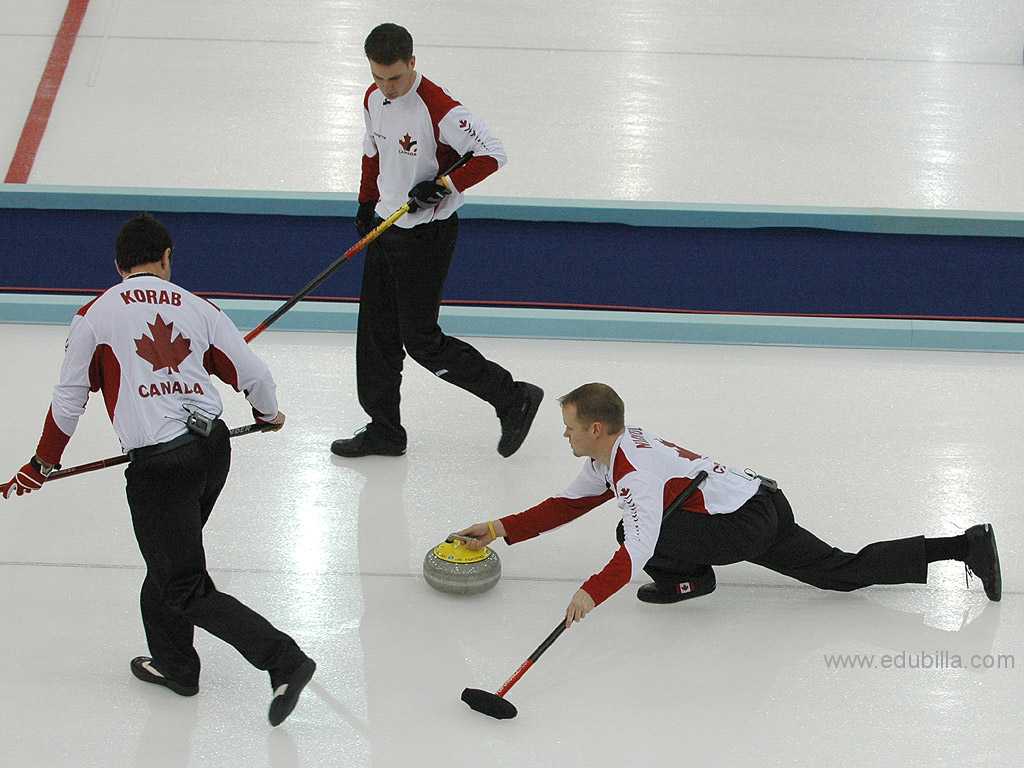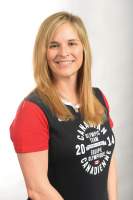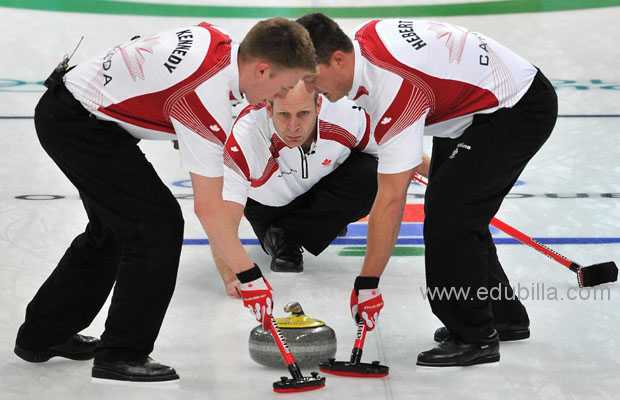
Overview Of Curling
Curling is a sport in which players slide stones on a sheet of ice towards a target area which is segmented into four concentric circles. It is related to bowls, boules and shuffleboard. Two teams, each with four players, take turns sliding heavy, polished granite stones, also called rocks, across the ice curling sheet towards the house, a circular target marked on the ice.[2] Each team has eight stones. The purpose is to accumulate the highest score for a game; points are scored for the stones resting closest to the centre of the house at the conclusion of each end, which is completed when both teams have thrown all of their stones. A game usually consists of eight or ten ends.
The curler can induce a curved path by causing the stone to slowly turn as it slides, and the path of the rock may be further influenced by two sweepers with brooms who accompany it as it slides down the sheet, using the brooms to alter the state of the ice in front of the stone. A great deal of strategy and teamwork go into choosing the ideal path and placement of a stone for each situation, and the skills of the curlers determine how close to the desired result the stone will achieve. This gives curling its nickname of "chess on ice".
Game Rules
Stones:
A rock must finish inside the inner edge (closest to the rings) of the hog line to be in play, except when it has hit another rock in play.
A rock that completely crosses the back line or touches the side board or side line is taken out of play.
Delivery:
Right-handed players deliver from the hack to the left of the centre line and left-handed players deliver from the hack to the right of the centre line. Any player may deliver from a hack on the centre line.
The hand must be clearly off the handle before the rock completely (i.e. back edge) passes over the hog line.
A rock that has not been released from the player’s hand may be returned to the hack and re-delivered as long as it has not reached the back line during delivery.
If a player delivers a rock out of proper order, and the mistake is not noted until after the rock has come to rest or hit another rock, the rock is in play. The player missing his turn will throw his rock as the last one for his team on that end. If the skips can’t agree who missed his turn, then the lead of the team that made the mistake will throw the last rock for his team in that end.
Sweeping:
Only one player from each team may sweep behind the tee line. Only the skip or third of the non-delivering team may sweep behind the tee line.An opposing team’s rock may only be swept behind the tee line.The delivering team has first right to sweep its rock behind the tee line, but shall not prevent the non-delivering team from doing so.
Only the skip or third of the non-delivering team may sweep their rocks set in motion by the delivering team.The sweeping motion must be from side to side across the rock’s running surface and must not leave debris in front of a moving rock.
All sweeping must take place no more than six feet in front of a rock in motion.When sweeping with a corn broom, the straw must be pointed in the direction of play. Sweeping backward with a corn broom is not allowed.If a rock in motion is touched by any player of the delivering team or his equipment before the far hog line, it shall be immediately removed from play. If the infraction occurs after the rock reaches the far hog line (not sure on this….)
If a stationary stone is moved by any player the non-offending team shall replace the stone as close as possible to its original position. If there is any question as to which stone(s) was closer to the button, the displaced stone is placed in favour of the non-offending team.
Measuring:
Measurements shall be taken from the button to the nearest part of the rock.No physical device may be used in measuring rocks until the last rock of the end has come to rest, except to determine if one of the first two rocks of an end is in the rings or the free guard zone.
If there is any doubt between the two opposing skips as to whether one of the first two rocks of an end finishes in the free guard zone, then a measuring device may be used to decide the matter.
Equipment:
No player shall use any footwear or equipment that may damage the surface of the ice.
At the start of a game, each curler must declare which broom or brush he will be using for sweeping. Brushes may be exchanged between players on the same team, but a corn broom cannot be exchanged.
Equipments Need For Curling
The Curling Equipment Programme (CEP) was designed to assist Member Associations by providing them with a specified amount of curling equipment for distribution at one of their organised camps or clinics.
Broom or brush:
There are two types of broom. The most common is a brush or "push broom". The other is a corn/straw/Canadian broom, which, with long bristles, looks much like a normal broom.
Ice:
For indoor tournaments the artificially created ice has its surface sprinkled with water droplets which freeze into tiny bumps on the surface. Called "pebbled ice", this surface helps the stone's grip and leads to more consistent curling.
Rink:
The rink is 42.07m long and 4.28m wide with a target - or house - at either end.
Shoes:
Special curling shoes are common; shoes should grip the ice well. While shooting, extremely slippery surfaces such as Teflon are used on the sliding foot. Some are built into the shoes and others are strapped on over the shoes.
Rock:
Also known as a stone, a curling rock is made of rare, dense granite that is quarried on Scotland's Ailsa Craig. Each rock weighs 19.1kg and is polished.
History Of Curling
One of the world’s oldest team sports, curling originated in the 16th century in Scotland, where games were played during winter on frozen ponds and lochs. The earliest-known curling stones came from the Scottish regions of Stirling and Perth and date from 1511. In the 1600s, stones with handles were introduced.
First Olympic Winter Games:
Men’s curling was included in the Olympic programme in 1924 at the first Olympic Winter Games in Chamonix. It was then dropped, and later re-introduced as a demonstration sport in 1932 in Lake Placid.
Between 1936 and 1992, curling was staged at the Games as a demonstration sport: in Garmisch-Partenkirchen in 1936 and Innsbruck in 1964, under the German name of “Eisschiessen”; and in 1988 in Calgary and in 1992 in Albertville, with both men’s and women’s events.
It was in Nagano in 1998 that it officially joined the Olympic programme, with both men’s and women’s competitions.
The first curling club:
The first curling club in the United States was organized in 1831 only 30 miles from Detroit at Orchard Lake, Michigan. Called the 'Orchard Lake Curling Club', the club used hickory block 'stones'. A Detroit Curling Club was started back in 1840 when Michigan only had a population of 212,000 and had only been in the Union for three years!
Along about this time an organization, called the 'Thistle Club' was founded, and curling being a winter sport, was played when the ice was right on the Detroit River at the foot of Joseph Campau, on the bay, and at the old Recreation Park. These clubs became the 'Granite Club' and in 1885 the present Detroit Curling Club was organized. At that time Detroit had a population of about 150,000 and its 'rapid' transit was horse-drawn. The Club was in action ten years before the first horseless carriages sputtered and backfired along Detroit's streets. Early curling matches were decided on the old Detroit Athletic Club field on the west side of Woodward Avenue, between Canfield and Forest Avenue, on natural ice, lighted by lanterns. The only similarity between those days and today was the red-faced, raucous shouts of the skips!
The first recognized Curling Clubs were formed in Scotland, and during the 19th Century the game was “exported” wherever Scots settled around the world in cold climates, most notably at that time in Canada, USA, Sweden, Switzerland, Norway and New Zealand.
Scotch Cup:
Interest in other countries was generated, and the USA (1961), Sweden (1962), Norway and Switzerland (1964), France (1966) and Germany (1967) expanded the Scotch Cup entry. The 1959-67 results now are recognized in the curling history of the men's world championship.
The success of the Scotch Cup series led to another attempt, in March 1965, to create a global administration. The Royal Caledonian Curling Club (Scotland) convened a meeting in Perth, Scotland, and six countries (Scotland, Canada, USA, Sweden, Norway and Switzerland) agreed to a proposal to form an international committee of the Royal Club, to be called the International Curling Federation (ICF).
World Junior Curling Championships (WJCC):
In 1968, the Air Canada Silver Broom replaced the Scotch Cup, and it was sanctioned as the World Curling Championship. In 1975, the Federation endorsed the World Junior Men's Curling Championship; in 1979 the Ladies’ Curling Championship; and in 1988, the World Junior Ladies’ Curling Championship. The four Events were combined into two in 1989 at Milwaukee, Wisconsin, and Markham, Ontario, and became known as the World Curling Championships (WCC) and the World Junior Curling Championships (WJCC).
World Mixed Doubles Curling Championship:
In 2008, the first World Mixed Doubles Curling Championship was staged in Vierumäki, Finland. Mixed Doubles Curling marks a break from traditional curling, as teams are comprised of two players – one male and one female. The Championship has grown from strength to strength and is now an annual fixture on the WCF calendar.
Curling Association of India (CAI):
Curling Association of India (CAI) is an organisation that developing Curling in India. Curling is Winter Olympic Sports. its played on Ice Surface in indoor rinks with the condition of the ice carefully temperature-controlled. Curling has been described as the “Roarin’ Game”, with the “roar” coming from the noise of a granite stone as it travels over the ice. Mr. Vitthal Shirgaonkar is the founder of Curling Game India. Development of this sport started in India with his participation in Curling Training Program held at Bratislava (Slovakia) in November 2012. The aim of the association is to develop this Winter Olympic Sport in India and produce more Curlers from India that will participate in various international curling championships and bright the name of India in Curling and Winter Olympic. CAI is the head of the all curling organisation affiliated with it and its units. Its headquarter is situated in Mumbai. The formation of the organisation is similar to tree where CAI is at top most level, the affiliated State units and its Affiliated District and Club units will work as per CAI guidelines.
Origin Of Curling
Curling has been described as the “Roarin’ Game”, with the “roar” coming from the noise of a granite stone as it travels over the ice. The exact origins of the game, however, are unclear, but curling is widely believed to be one of the world’s oldest team sports.
First Written Reference:
Curling was invented in medieval Scotland, with the first written reference to a contest using stones on ice coming from the records of Paisley Abbey, Renfrewshire, in February 1541. Two paintings, 'Winter Landscape with a Bird Trap' and 'The Hunters in the Snow' (both dated 1565) by Pieter Bruegel the Elder depict Flemish peasants curling—Scotland and the Low Countries had strong trading and cultural links during this period, which is also evident in the history of golf.
The first Rules:
The first Rules were drawn up in Scotland, and they were formally adopted as the “Rules in Curling” by the Grand Caledonian Curling Club, which was formed in Edinburgh in 1838 and became the sport’s governing body. Four years later, following a demonstration of curling on the ballroom floor of Scone Palace near Perth by the Earl of Mansfield during a visit by Queen Victoria, the Queen was so fascinated by the game that in 1843 she gave permission for the Club’s name to be changed to the Royal Caledonian Curling Club (RCCC).
First World Championship:
The first world championship for curling was limited to men and was known as the Scotch Cup, held in Falkirk and Edinburgh, Scotland, in 1959. The first world title was won by the Canadian team from Regina, Saskatchewan, skipped by Ernie Richardson.
Governing Bodies
World Curling Federation (WCF):
The World Curling Federation (WCF) is the world governing body for curling accreditation, with offices in Perth, Scotland. It was formed out of the International Curling Federation (ICF), when the push for Olympic Winter Sport status was made. The name was changed in 1991.
The WCF is managed by eight Board Directors, one president, three vice-presidents (one from each WCF regional zone - Americas, Europe, Pacific-Asia) and six Board Directors. The six Board Directors must all come from different member associations. All positions on the Board of Directors are elected by WCF member associations. The Board of Directors are supported by and a permanent staff of 14 employees. There are currently 54 member associations.
International Curling Federation (ICF):
The ICF was initially formed in 1965 as a committee of the Royal Caledonian Curling Club in Perth after the success of the Scotch Cup series of world championships held between Canada and Scotland. At the outset, it comprised the associations of Scotland, Canada, Sweden, Norway, Switzerland, and the United States. In the wake of its formation, it sanctioned the World Curling Championships. The WCF currently sanctions fifteen international curling events
Mission Statement:
The World Curling Federation represents curling internationally and facilitates the growth of the sport through a network of Member Associations/Federations.
About the WCF:
The World Curling Federation is the world governing body of the Olympic Winter Sport of Curling and the Paralympic Winter Sport of Wheelchair Curling. Originally founded in 1966 as the International Curling Federation, the ICF changed its name to the World Curling Federation in 1991.
Today, the WCF is managed by an Executive Board of seven, each from a different country and elected by WCF Member Associations. A permanent staff of fifteen employees is based out of the WCF Secretariat in Perth, Scotland.
Curling is generally acknowledged to be one of the fastest-growing international winter sports.
The Spirit of Curling:
Curling is a game of skill and of tradition. A shot well executed is a delight to see and it is also a fine thing to observe the time-honoured traditions of curling being applied in the true spirit of the game. Curlers play to win, but never to humble their opponents. A true curler never attempts to distract opponents, nor to prevent them from playing their best, and would prefer to lose rather than to win unfairly.
Curlers never knowingly break a rule of the game, nor disrespect any of its traditions. Should they become aware that this has been done inadvertently, they will be the first to divulge the breach.
While the main object of the game of curling is to determine the relative skill of the players, The Spirit of Curling demands good sportsmanship, kindly feeling and honourable conduct.
This spirit should influence both the interpretation and the application of the rules of the game and also the conduct of all participants on and off the ice.
To Visit WCF Click Here
Awards Related To Curling
WCF Curling Awards
WWhCC Sportsmanship Award:
All Participants are invited to nominate a fellow competitor who, in their view, has best exemplified the traditional values of skill, honesty, fair play, sportsmanship and friendship during these
WJCC Sportsmanship Award:
All Participants are invited to nominate a fellow competitor who, in their view, has best exemplified the traditional values of skill, honesty, fair play, sportsmanship and friendship during these
World Curling Freytag Award:
The World Curling Freytag Award is a tribute to the late Elmer Freytag of the U.S Curling Association, one of the founding members of the International Curling Federation (now WCF).
Collie Campbell Memorial Award:
The Collie Campbell Memorial Award was created in honour of Canadian Collie Campbell who served as President of the International Curling Federation (later renamed the World Curling Federation) from
Frances Brodie Award:
Frances Brodie was the driving force behind the group which established the first World Ladies Curling Championship in 1979 and chaired the first Official Ladies Committee of the International
Sample Documents Of Curling
-Sachin Tendulkar

